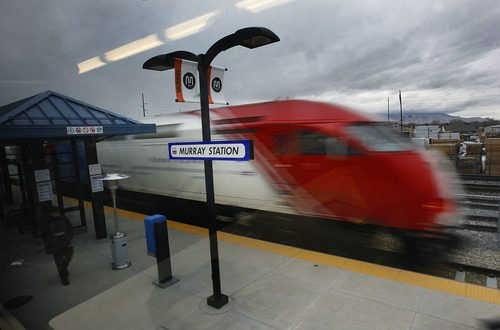This is an archived article that was published on sltrib.com in 2013, and information in the article may be outdated. It is provided only for personal research purposes and may not be reprinted.
To fix out-of-whack schedules for FrontRunner commuter trains, the Utah Transit Authority announced Tuesday that it will make extensive schedule changes beginning Feb. 19 — including tweaking timing on 45 bus routes that connect to the trains. It will also double the window in which the trains offer peak, every-30-minute service.
Normally, UTA would not alter schedules again until April 14, and tries to make adjustments only three times a year — in August, April and December. But published schedules have had little to do with actual operations, so changes were rushed.
"When we opened the new FrontRunner line from Salt Lake City to Provo in December, we found that our published schedule was too tight. We had operated it during testing and thought we could meet it. But when we operated with passengers, we found it wasn't working" because it took longer to load and unload riders than planned, said UTA spokesman Gerry Carpenter.
"That caused trains to be much later than anticipated, and many passengers missed buses or other connections," he said. "This is the quickest we could change schedules" and meet legal requirements for notification and actually print and advertise new schedules.
New schedules are available online at rideuta.com, or specifically at bit.ly/gV77nw.
Also, Carpenter said the new FrontRunner service has such high demand — despite schedule foul-ups — that UTA has decided to double the hours that it will offer peak, once-every-30-minute service. It is also adding extra trains to handle crowds.
Carpenter said UTA also had extensive requests from passengers and employers for extended once-every-30-minute service on FrontRunner. Previously, that was offered between 5 a.m. and 8 a.m. and 4 p.m. and 6 p.m., or five hours a day. Now, it will be offered between 5 a.m. and 10 a.m., and 4 p.m. and 9 p.m. — or 10 hours a day. At other operating times, trains come only once an hour.
"We believe that will give passengers more travel options, especially if they have to stay at work late," Carpenter said. He noted the number of trips traveling the full length of the line from Ogden to Provo will increase from 19 to 23. The number of peak trips traveling half of the line will increase from nine to 10.
But the schedule changes will make the trips slower, to allow for longer stops in downtown Salt Lake City and to create some recovery time in case trains fall behind schedule.
Northbound trips will increase run times by 15 minutes — nine extra minutes to travel between Provo and Salt Lake Central, and six additional minutes between Salt Lake Central and Ogden.
Southbound trips will increase run times by 16 minutes — with 11 additional minutes between Ogden and Salt Lake Central, and five additional minutes between Salt Lake Central and Provo. The difference in northbound and southbound trip times is because of the way trains meet and pass each other.
UTA is also changing schedules on 45 different bus routes that connect with FrontRunner in Salt Lake, Utah, Davis and Weber counties. A list of them and the changes is available online. UTA is not making any schedule changes now to its TRAX light rail lines.
The agency said it will have extra staff to answer questions and assist passengers on the Feb. 19 change date at some of its busiest stations in Provo, Lehi, Murray, Salt Lake Central and North Temple.
It also said that during peak operating hours, UTA staff now will manually update FrontRunner display boards to provide more reliable arrival and information. The agency had received criticism that the boards were unreliable.
UTA also said it will continue to provide service updates online on its Facebook page and on Twitter, as well as feed information to several private third-party schedule and tracking apps.



